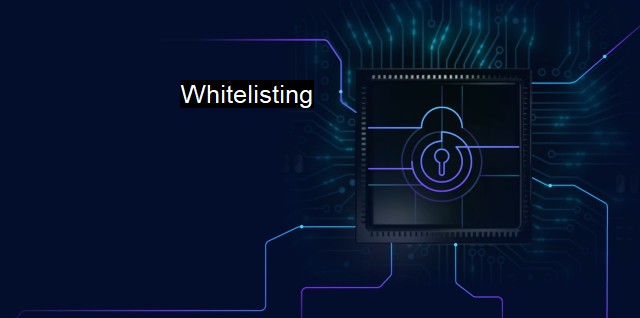What is Whitelisting?
The Importance of Whitelisting in cybersecurity: An Effective Defensive Strategy Against Malware Infections
Whitelisting is a cybersecurity strategy that permits access to authorized users, devices, and applications. It is critical in the regulation of user access in digital environments, such as computer networks and mobile devices. The concept hinges on its antonym –blacklisting - which disallows unauthorized users, untrusted applications, and suspicious websites.The effective administration of whitelisting holds tremendous potential for companies and individuals by mitigating potential cybersecurity threats. In many respects, this preemptive approach to cybersecurity is more valuable than trying to weed out threats after they have already gained access. Antivirus programs heavily use it to protect computer systems and networks from malware, viruses, and other cybersecurity issues.
The primary purpose of whitelisting stems from digital security. Its foremost aim is to establish a specific list of permitted entities; this could range from email addresses to websites and users or apps. By doing this, the critiqued 'accept all unless explicitly denied' mechanism switches consciously towards a more cautious 'deny all, unless explicitly allowed,' offering a more powerful security standing.
Whitelisting has versatile uses across several domains of internet use, cybersecurity, and data protection. Employed effectively, it dramatically constrains the likelihood of encountering dangerous online threats, such as malware, phishing attacks, or ransomware.
Email whitelisting is among the most common uses in the cybersecurity world. If an email address is on the white list, it won't go into a spam or junk folder. the non-whitelisted entities face prompt rejections. In this manner, email whitelisting successfully counters threats of harmful phishing campaigns.
Software whitelisting is another scenario where certain specific apps, software, and programs acquire permission to run on your device. An antivirus applies a whitelisting approach to permit these safe-to-use software, ensuring you never inadvertently introduce malware. This mechanism largely bolsters a computer's safety against common threats like ransomware or Trojan horses, which often enter disguised as innocuous software.
Network administrators also use whitelisting strategies to regulate data exchange within a network. They can permit specific computers, addresses, and even websites, making the network a safe playing field for all approved digital 'players.' Hence, network whitelisting becomes a powerful and practical method to scrutinize and authorize users and connections, improving overall network security.
Despite its many advantages, there is considerable debate over whitelisting's effectiveness and feasibility in numerous contexts. While it offers stringent control, it is tedious, limits flexibility and requires continual updating. An overly restrictive list compromises productivity, while a poorly maintained whitelist can become a gateway for old but destructive malware. Therefore, managing a balance between security and practical functioning is crucial.
Antivirus software uses whitelisting heavily, playing a crucial role in differentiating between safe and unsafe files, websites, and software. it's important to remember that not all antivirus software recognizes the same files and websites as safe, creating a kind of perplexing disparity in practice.
Lately, false positives are another problematic area in the realm of whitelisting. These are essentially false alarms where safe entities are treated as threats leading to needless blockades. This inconvenience and time consumption due to such false positives also deter the mass-scale application of whitelisting.
All things considered, whitelisting is a valuable tool in the cybersecurity roadmap and antivirus methodologies. With the rise of cyber threats and the unlucky reality of data breaches, it can offer a sturdy line of defense. The sheer existence of numerous advantages, coupled with the scope of minimizing loopholes, ensures whitelisting's continued evolution to stay agile in the dynamic sphere of cybersecurity.

Whitelisting FAQs
What is whitelisting in cybersecurity and antivirus?
Whitelisting is a security measure used by antivirus and other cybersecurity solutions that allows only pre-approved programs and applications to communicate with your computer systems.How does whitelisting differ from blacklisting?
Whitelisting and blacklisting are opposite approaches to security. While whitelisting allows only pre-approved programs to run, blacklisting blocks or denies access to known malicious programs or applications.What are the advantages of using whitelisting for cybersecurity?
Whitelisting provides a more effective defense against cyber attacks compared to traditional antivirus programs that rely on blacklisting. With whitelisting, only known, trusted applications are allowed to run, reducing the risk of malware infections and data breaches.Can whitelisting cause any issues with legitimate programs or applications?
Whitelisting can sometimes cause issues with legitimate programs or applications that are not included in the approved whitelist. However, most whitelisting solutions have user-friendly interfaces and allow users to manually approve or add exceptions for certain programs.| | A | | | B | | | C | | | D | | | E | | | F | | | G | | | H | | | I | | | J | | | K | | | L | | | M | |
| | N | | | O | | | P | | | Q | | | R | | | S | | | T | | | U | | | V | | | W | | | X | | | Y | | | Z | |
| | 1 | | | 2 | | | 3 | | | 4 | | | 7 | | | 8 | | |||||||